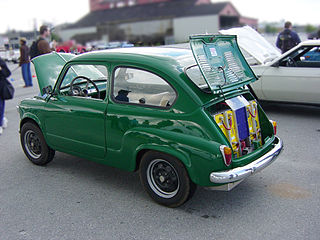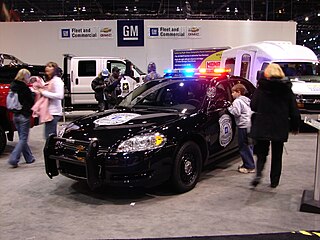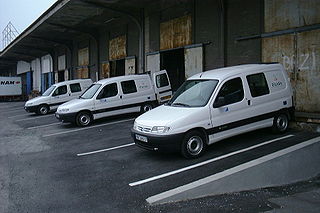
An electric vehicle (EV) is a vehicle whose propulsion is powered fully or mostly by electricity. EVs include road and rail vehicles, electric boats and underwater vessels, electric aircraft and electric spacecraft.

A vehicle start-stop system or stop-start system automatically shuts down and restarts the internal combustion engine to reduce the amount of time the engine spends idling, thereby reducing fuel consumption and emissions. This is most advantageous for vehicles that spend significant amounts of time waiting at traffic lights or frequently come to a stop in traffic jams. Start-stop technology may become more common with more stringent government fuel economy and emissions regulations. This feature is present in hybrid electric vehicles, but has also appeared in vehicles that lack a hybrid electric powertrain. For non-electric vehicles, fuel economy gains from this technology are typically in the range of 3–10%, potentially as high as 12%. In the United States, according to the Department of Energy, idling wastes more than 6 billion U.S. gallons of fuel per year.

A dashboard is a control panel set within the central console of a vehicle, boat, or cockpit of an aircraft or spacecraft. Usually located directly ahead of the driver, it displays instrumentation and controls for the vehicle's operation. An electronic equivalent may be called an electronic instrument cluster, digital instrument panel, digital dash, digital speedometer or digital instrument cluster. By analogy, a succinct display of various types of related visual data in one place is also called a dashboard.

On-board diagnostics (OBD) is a term referring to a vehicle's self-diagnostic and reporting capability. In the United States, this capability is a requirement to comply with federal emissions standards to detect failures that may increase the vehicle tailpipe emissions to more than 150% of the standard to which it was originally certified.

In automobile engineering, electric vehicle conversion is the replacement of a car's combustion engine and connected components with an electric motor and batteries, to create a battery electric vehicle (BEV).

9C1 is a production code used by Chevrolet to designate a vehicle intended for use as a police car or car-based emergency vehicle. 9C1-designated vehicles are marketed under the Police Pursuit Vehicle or Police Patrol Vehicle (PPV) nameplate. The 9C1 package is intended to compete with the Ford Police Interceptor and Stellantis's Dodge Charger Pursuit and Dodge Durango Pursuit.

A motor vehicle has lighting and signaling devices mounted to or integrated into its front, rear, sides, and, in some cases, top. Various devices have the dual function of illuminating the road ahead for the driver, and making the vehicle visible to others, with indications to them of turning, slowing or stopping, etc., with lights also indicating the size of some large vehicles.
A transmission control unit (TCU), also known as a transmission control module (TCM), or a gearbox control unit (GCU), is a type of automotive ECU that is used to control electronic automatic transmissions. Similar systems are used in conjunction with various semi-automatic transmissions, purely for clutch automation and actuation. A TCU in a modern automatic transmission generally uses sensors from the vehicle, as well as data provided by the engine control unit (ECU), to calculate how and when to change gears in the vehicle for optimum performance, fuel economy and shift quality.
A throttle is a mechanism by which fluid flow is managed by construction or obstruction.

A check engine light or malfunction indicator lamp (MIL), is a tell-tale that a computerized engine-management system used to indicate a malfunction or problem with the vehicle ranging from minor to serious. Found on the instrument panel of most automobiles, it usually bears the legend engine, check engine, service engine soon, maintenance required, emiss maint, or a pictogram of an engine—and when illuminated, it is typically an amber or red color.
The following outline is provided as an overview of and topical guide to automobiles:

Brake-by-wire technology in the automotive industry is the ability to control brakes through electronic means, without a mechanical connection that transfers force to the physical braking system from a driver input apparatus such as a pedal or lever.

The Citroën Berlingo électrique is a battery-powered version of the first-generation Berlingo range of vans, built and sold between 1998 and 2005. It has a 162 V Saft NiCd battery, a 28 kW Leroy Somer electric motor and has a maximum speed of 95 km/h (59 mph), with a maximum range of 95 km (59 mi) in typical driving. It replaces the C15 électrique.
An annunciator panel, also known in some aircraft as the Centralized Warning Panel (CWP) or Caution Advisory Panel (CAP), is a group of lights used as a central indicator of status of equipment or systems in an aircraft, industrial process, building or other installation. Usually, the annunciator panel includes a main warning lamp or audible signal to draw the attention of operating personnel to the annunciator panel for abnormal events or condition.

The Honda XL175 was a motorcycle produced by Honda. The XL175 first entered the market in 1973 as a lightweight dual-sport motorcycle, and the model continued in production through 1978. The XL175 had a 173cc single cylinder OHC four-stroke engine mated to a 5-speed transmission and was started via a kickstarter only. The gauges included a speedometer and a tachometer up until 1976, when the tachometer was deleted for that and subsequent years. Braking was via front and rear cable operated drum brakes. The dimensions of the bike were 2,075x840x1,095mm (82x33x43in).
Warning light may refer to:

An alternator is a type of electric generator used in modern automobiles to charge the battery and to power the electrical system when its engine is running.

Car controls are the components in automobiles and other powered road vehicles, such as trucks and buses, used for driving and parking.















